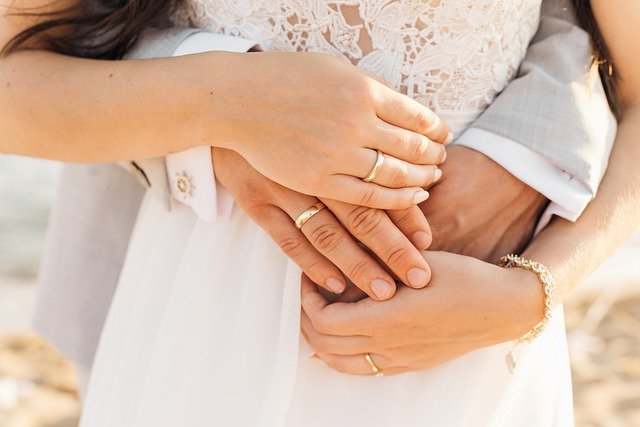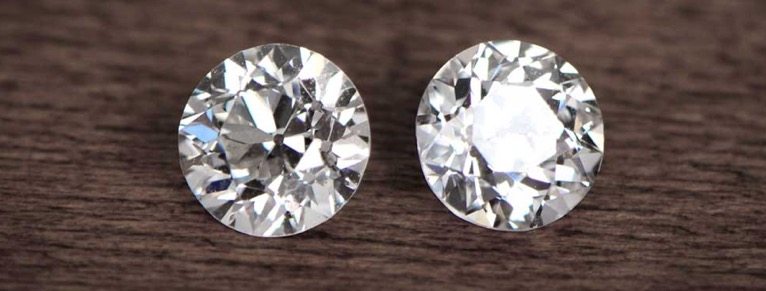
Everything You Need to Know About 10K Gold
December 29, 2021
Should You Buy a Lab-Grown Diamond?
May 22, 2022Moissanite vs. Diamond: Which is Better?

White sapphire. Cubic Zirconia. Colorless rutile. There are many types of gems used to imitate diamonds. But one that comes up often is moissanite. However, moissanite is much more than an imitation.
They’re very different from diamonds, but they do have their own, very distinct advantages, such as their brilliance, clarity, and price. So how do they fare when compared to diamonds? In this article, we will be analyzing the moissanite vs. diamond debate.
- What is Moissanite?
- Moissanite vs. Diamond: The Quick Guide
- Telling the Difference Between Moissanite and Diamond
- Reasons to Purchase Moissanite
- The Disadvantages of Moissanite
- Comparing the Qualities of Moissanite and Diamond
- Our Final Recommendations
What is Moissanite?
When you hear the word ‘moissanite’, you might think of cheaper stones meant to mimic diamonds. Moissanite is actually a gemstone in its own right.
Named after its discoverer, French scientist Henri Moissan, moissanite is a near-colorless gemstone. While examining a meteor crater in Arizona in 1893, Moissan originally thought he’d found diamonds, he later realized the gemstone was made of naturally occuring silicon carbide. This is actually a very rare mineral, and until the 1950s, the only source of moissanite was meteor craters. Today, moissanite is usually manufactured, but naturally occuring moissanite was found to have formed around stars that burn around 1000 times brighter than our Sun.
Moissanite vs. Diamond: The Quick Guide
For a quick reference guide, consult this table to see the differences between moissanite and diamond.
| Moissanite | Diamond |
| Pure carbon | Silicon carbide |
| Colorless diamonds will have no yellow hues | Not colorless |
| Naturally mined or lab-created | Lab-created (natural moissanite exists in minute amounts) |
| More expensive | Lower price |
| More valuable | Less valuable |
| Graded by international bodies | Graded by manufacturer |
| Perfect light refraction | More sparkle than a diamond |
Still considering a moissanite?
Telling the Difference Between Moissanite and Diamond
Moissanite and diamond can actually be quite similar in appearance, especially to the untrained eye and when set within jewelry, such as an engagement ring. However, there are ways that anyone can tell the difference.
Clarity
The clarity of moissanite is usually high as they’re man-made, which means they don’t come with the naturally-occurring inclusions that diamonds can.
Weight
As diamonds are naturally dense forms of carbon, they’re heavier than moissanite (when comparing two stones of the same size). In fact, when comparing stones such as these, the moissanite has been found to be 15% lighter.
Value
Diamonds will always be the most expensive gemstone on the market. Moissanite is a lot less expensive. This means you can get larger stones for your jewelry for a much smaller price. But it also means that there is not much longevity to the bought value of moissanite in comparison to diamond.
Color
Moissanites aren’t colorless. They may appear colorless, but viewed under specific light sources will show green, yellow, or grey tints. In comparison, diamonds can be colorless.
Light Performance
In terms of brilliance and fire, moissanite actually produces higher levels of both. With moissanite, you will find that they usually have stronger flashes of color and produce more sparkle.
So are they worth buying?
Reasons to Purchase Moissanite
Of course, the first quality of moissanite that might attract buyers is its price. It’s far less expensive than diamond, meaning you can literally get more for your money. Similarly, you’re more likely to find consistently high clarity moissanite because they’re lab manufactured, which helps a lot when trying to find matching stones.
They also have a high refractive index, meaning their sparkle and fire is noticeably increased in comparison to diamonds. Some diamond and gemstone purists find this level of sparkle unnatural, while others enjoy how eye-catching moissanite can be.
There’s also ethics to consider. As moissanite are lab-created, they are more than likely never linked to unethical mining practices. That being said, the vast majority of diamonds on the market today are also ethically sourced due to modern regulation, tracking, and enforcement techniques.
The Disadvantages of Moissanite
Moissanite doesn’t come without its downsides. Initially, there’s the lack of value to contest with. Moissanite will never be as expensive as diamonds and also won’t keep its value over time. We wouldn’t say that they are an investment, like diamonds can be, and also don’t have the ‘heirloom’ quality that diamonds have.
We’ve also got to talk about the ‘unnatural’ brilliance we mentioned previously. Moissanite produces an intense sparkle, which can look almost too good to be true. For those looking for the very best, this might seem over-the-top, and noticeable to viewers. The sparkle might also be a giveaway that moissanite is artificially-produced.
There’s also the potential connotation of ‘cheapness’ when looking at gemstones that aren’t diamonds (or other well-known types such as emeralds or rubies). While this is fully subjective, a wearer of moissanite may not want to deal with people who hold such opinions.
Comparing the Qualities of Moissanite and Diamond
In the debate of moissanite vs. diamond, there are a number of important factors to consider.

Diamond vs Moissanite
Color
In dim lighting or at a distance, these two types of gemstone can look very similar in terms of color. However, when viewed up close, there’s some very obvious differences. To begin with, most moissanites have a yellow or green tint to them.
The moissanite also isn’t graded in color like diamonds are. If they were, they’d probably find themselves being graded as a K, which is on the lower end of the color scale. Furthermore, the larger the moissanite (which usually are larger than diamonds due to their less expensive price), the more likely it is you can see these tints.
In contrast, diamonds can hit that ultimate ‘colorless’ description, which gives them that amazing white-light sparkle.
Clarity
As we mentioned, moissanites have consistent clarity because it can be standardized under lab conditions. This means they won’t have the inclusions or blemishes that can naturally occur in diamonds. However, this isn’t to say they’re blemish-free, as they can pick up these imperfections within their manufacturing or throughout their lifetime.
One of the issues with clarity when applied to moissanite is that these gradings aren’t provided by an impartial lab, such as the GIA or the AGS. It’s often either the manufacturer or the seller which provides this, which does introduce an element of bias to the grading. In some scenarios, this may mean that moissanites are priced higher than they should be.
However, the artificially-given clarity is a boon. It means that moissanites are rarely not flawless, which is a very appealing quality.
Our Final Recommendations
However, moissanite can be a very appealing and beautiful gemstone to use in your jewelry. It’s a fantastic choice for those looking to spend a small budget. However, you must consider the downsides to making a moissanite purchase. I personally believe that the biggest issue is the lack of value. Diamonds are an investment that retain their value, whereas purchasing moissanite, while it can provide a good-looking piece of jewelry, you won’t be able to get that money back.
Ultimately, we’re always going to recommend the real thing. Diamonds are timeless, unique, natural, valuable, and tied to concepts of unity, eternity, and love. There’s a reason they have the larger price tag—they’re undeniably gorgeous and well worth the money spent on them.
However, finding the right diamond is always a labor of love. You need to research tirelessly before making a decision. However, there are ways of speeding up your decision-making process. For example, you could head to our education section to learn all about diamonds, which will help inform your ultimate purchasing decision.

